Few things are as disappointing to plant lovers as spotting brown, crispy edges on what were once vibrant, lush leaves. You water carefully, provide sunlight, and even talk to your plants—but those dry, brown tips keep showing up. The truth is, brown leaf tips are one of the most common plant problems, and they’re usually a sign that something in your plant’s environment or care routine needs adjustment.
The good news? This issue is often cosmetic and completely fixable. Once you understand why it happens, you can stop it from spreading and restore your plant’s healthy green glow.
Here’s a detailed guide on why your plant has brown leaf tips—and how to stop it for good.
1. Low Humidity Is Drying Out Your Plant
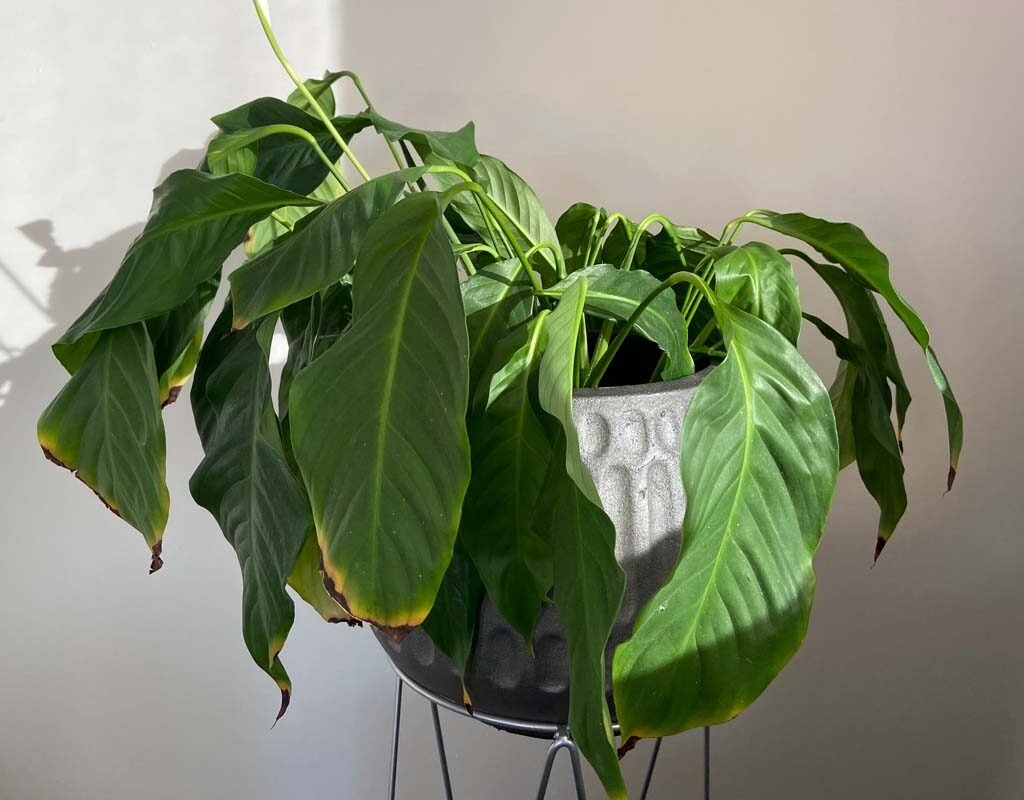
Indoor air, especially in homes with air conditioning or heating, can be far drier than most plants prefer. Many popular houseplants, like ferns, calatheas, peace lilies, and philodendrons, come from tropical regions where humidity levels hover around 60–80%. When indoor humidity drops below 40%, the leaf edges lose moisture faster than the plant can replace it—causing those brown, crispy tips.
Signs of Low Humidity:
- Leaf tips or edges turning brown and dry.
- Curling or thin, papery leaves.
- Slower overall growth or drooping.
What to Do:
- Increase Humidity Naturally: Place plants close together to create a mini microclimate where they can share moisture.
- Use a Humidifier: A small humidifier near your plants can keep humidity steady, especially in winter.
- Try a Pebble Tray: Fill a shallow tray with pebbles and water, and place the plant pot on top. As the water evaporates, it gently raises humidity.
- Mist (with Caution): Lightly misting can provide short-term relief but shouldn’t replace other humidity methods.
Maintaining proper humidity not only prevents brown tips but also encourages vibrant foliage and stronger growth.
2. You’re Overwatering (or Underwatering)
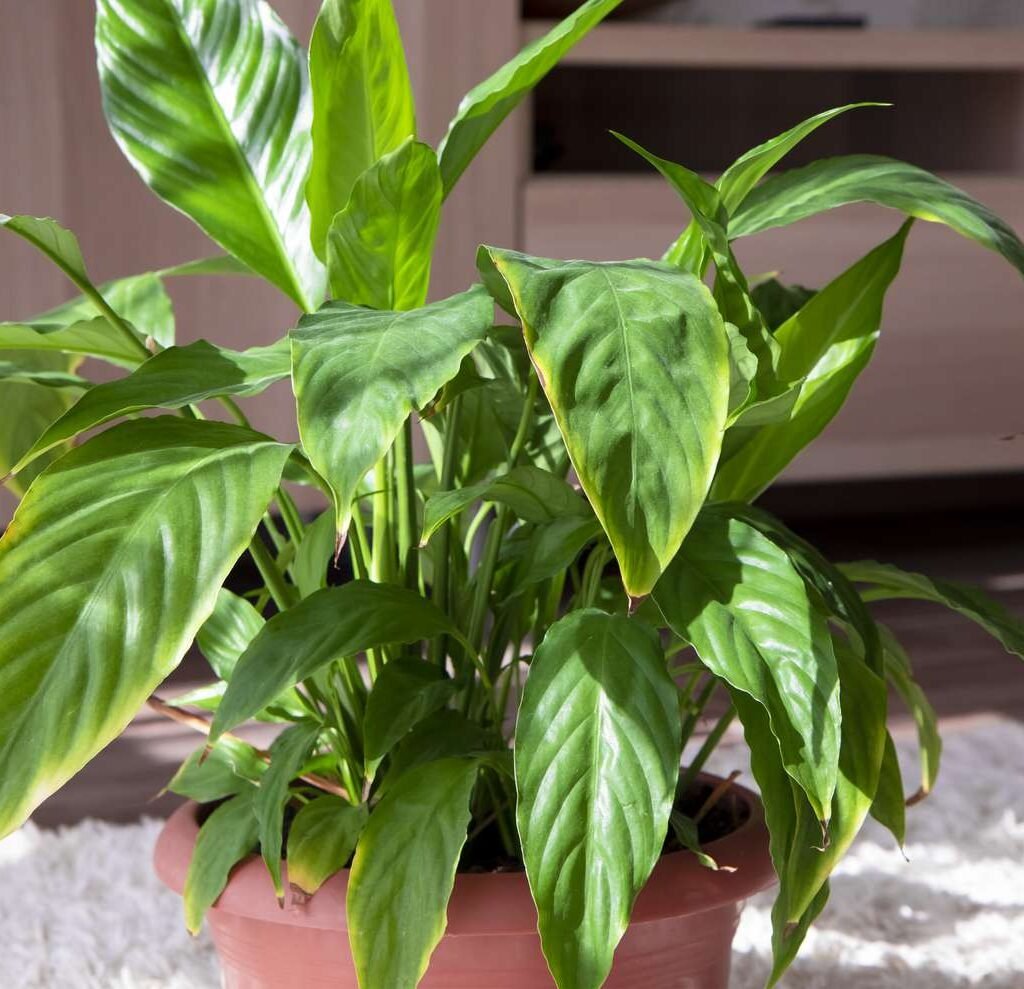
Watering habits are a major culprit behind brown leaf tips. Both overwatering and underwatering stress your plant—but in different ways.
When overwatered, roots sit in soggy soil and can’t breathe properly. Over time, this leads to root rot, which disrupts nutrient uptake, causing browning and yellowing of leaves.
When underwatered, the plant can’t transport enough water to the leaf tips, leaving them dry and brown.
How to Identify the Problem:
- Overwatering: Soft, yellowing leaves, mushy stems, and a musty smell from the soil.
- Underwatering: Dry soil pulling away from the pot edges, wilting, and crispy brown leaves.
How to Fix It:
- For Overwatered Plants:
- Stop watering immediately.
- Remove the plant from its pot and trim away any mushy, brown roots.
- Repot in fresh, well-draining soil and a container with drainage holes.
- For Underwatered Plants:
- Give the plant a deep soak. Place the pot in a basin of water for 15–30 minutes.
- Ensure the soil is evenly moist, not soggy.
- Adjust your watering schedule—most plants prefer watering only when the top inch of soil feels dry.
A consistent watering routine tailored to each plant’s needs is the simplest way to prevent brown leaf tips caused by water stress.
3. Your Water Quality Might Be the Problem
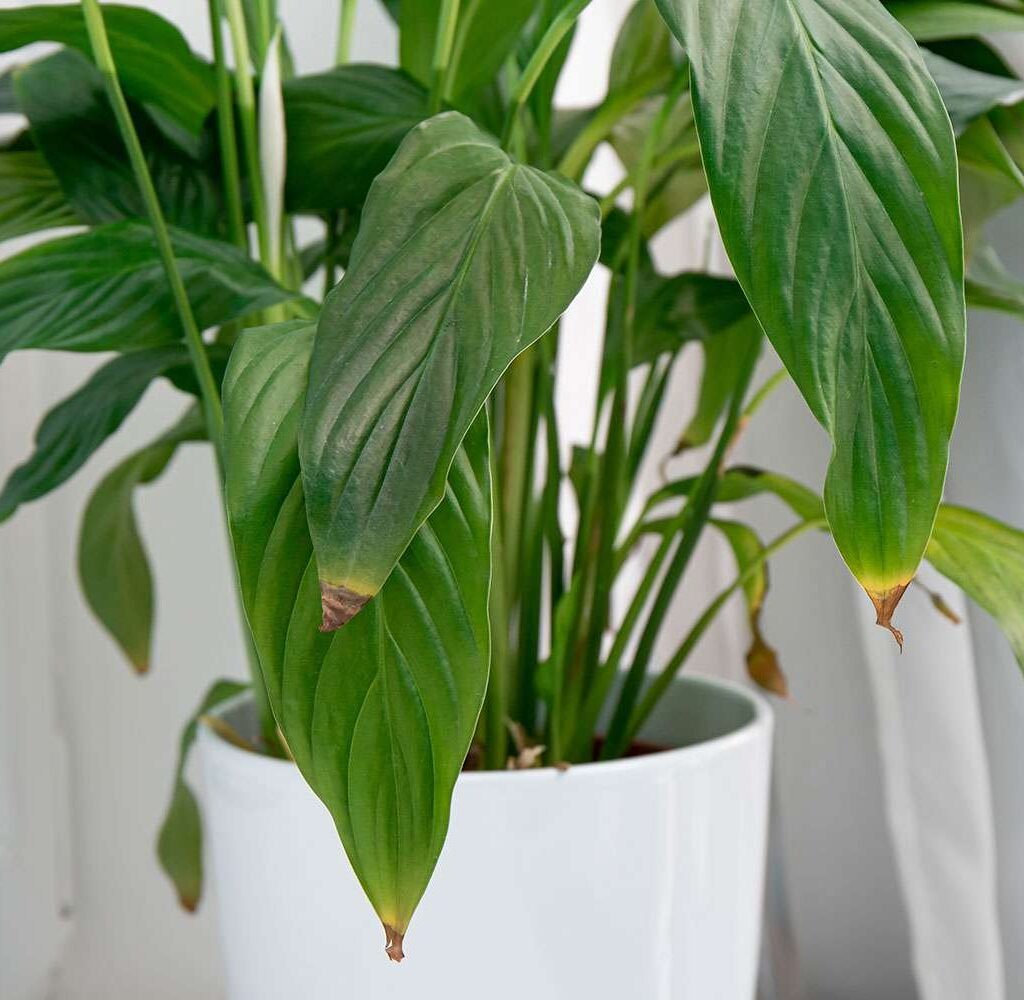
Even if your watering habits are perfect, the type of water you use could be harming your plant. Tap water often contains chlorine, fluoride, or high mineral content, which can accumulate in the soil over time. These substances damage delicate root hairs and leaf tissues, causing brown tips, especially on sensitive species like spider plants, dracaenas, and calatheas.
Signs of Water Quality Issues:
- Brown, crispy tips on new and old leaves alike.
- White crust on the soil surface or pot edges (mineral buildup).
- Slowed or distorted growth despite good lighting and humidity.
How to Fix It:
- Use Filtered or Distilled Water: These are free from chemicals that can harm roots.
- Let Tap Water Sit Overnight: Allowing it to sit uncovered for 24 hours lets chlorine evaporate.
- Flush the Soil: Once a month, pour clean water through the soil until it runs out of the drainage holes. This helps wash away built-up salts and minerals.
Over time, switching to cleaner water can completely eliminate brown tips and give your plant a fresh, green start.
4. Fertilizer Burn Is Scorching Your Leaves
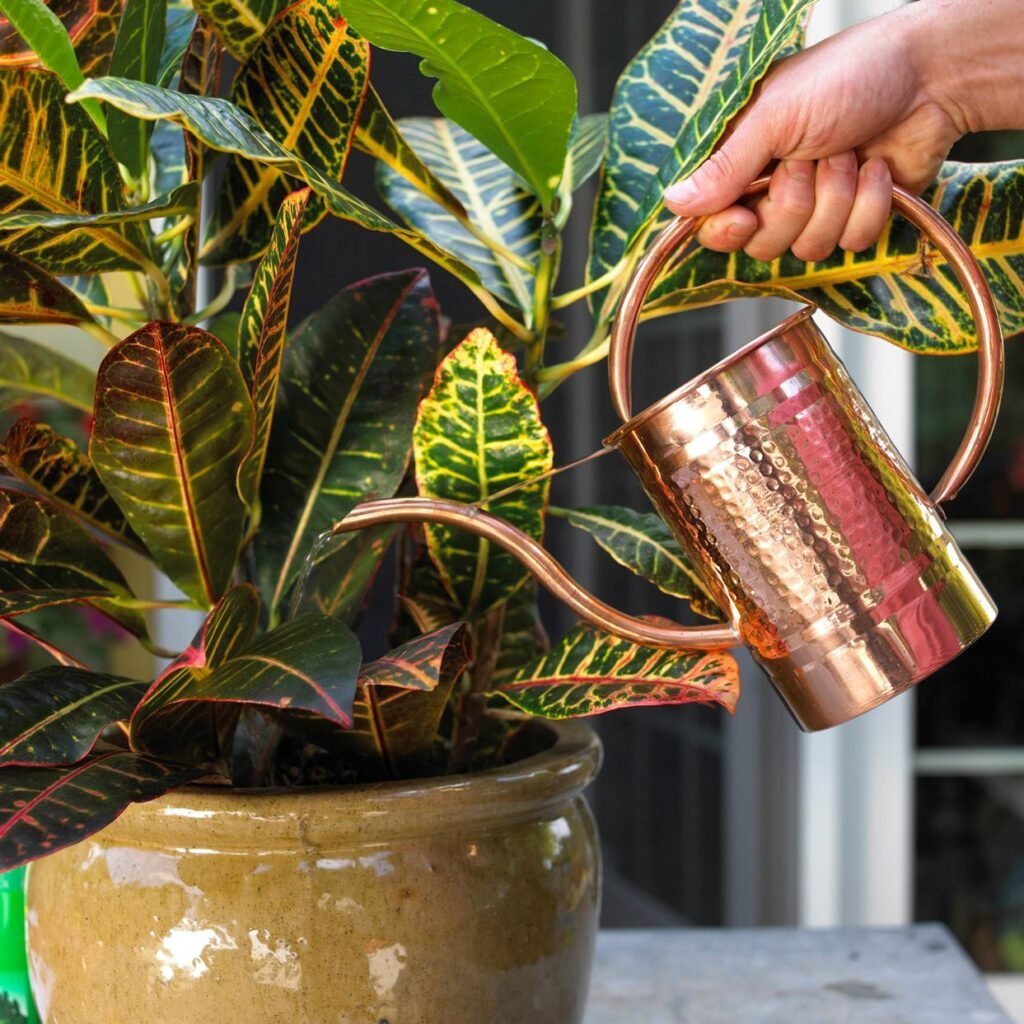
Fertilizers are meant to feed your plant, but too much of a good thing can do serious damage. Over-fertilizing causes a buildup of salts in the soil, which draws moisture out of the roots and leaf tips—essentially “burning” them.
Symptoms of Fertilizer Burn:
- Brown leaf tips or margins.
- White crust on soil or pot surface.
- Sudden leaf drop or stunted growth after feeding.
What to Do:
- Flush the Soil: Run water through the pot for a few minutes to wash away excess fertilizer salts. Let it drain fully.
- Skip Feeding for a Month: Give the plant time to recover before resuming any fertilization.
- Use Diluted Fertilizer: Always mix fertilizer to half the recommended strength.
- Feed Sparingly: Most indoor plants only need fertilizer every 4–6 weeks during their growing season (spring and summer).
If your plant’s tips have burned due to overfeeding, you can trim the brown portions with sterilized scissors to improve its appearance—but be sure to fix the root cause first.
5. Temperature Stress Is Hurting Your Plant
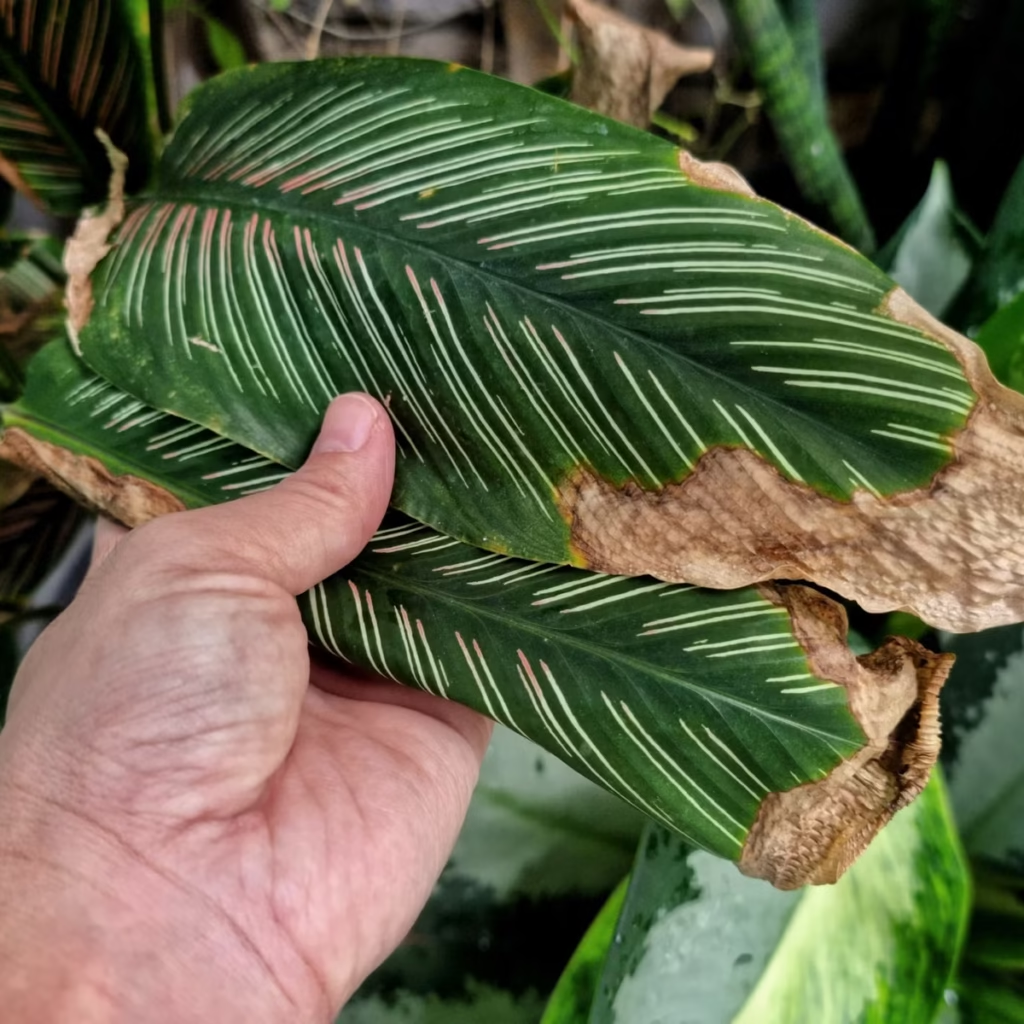
Extreme temperatures—either too hot or too cold—can also lead to brown tips. Indoor plants are particularly sensitive to sudden drafts, heaters, and air conditioning units. Rapid changes in temperature cause the plant to lose moisture faster than it can replenish it, leading to dehydration at the leaf edges.
Signs of Temperature Stress:
- Leaves curling, drooping, or developing brown patches overnight.
- Plants placed near radiators, windows, or vents showing leaf damage on one side.
- Growth slowing or stopping unexpectedly.
How to Fix It:
- Keep plants away from direct heat sources (like radiators or heaters).
- Avoid placing them in cold drafts or near frequently opened doors.
- Maintain indoor temperatures between 65–80°F (18–27°C) for most houseplants.
- Use a digital thermometer to monitor room temperature stability.
Consistency is key—plants thrive when their environment remains steady.
6. Poor Air Circulation and Dust Buildup
Dusty leaves can actually suffocate your plant. When dust covers the leaf surface, it blocks light and prevents proper gas exchange, slowing photosynthesis and leading to stress symptoms like browning. Similarly, stagnant air increases the risk of fungal infections that can also cause discoloration.
How to Fix It:
- Clean Leaves Regularly: Wipe leaves with a damp, soft cloth every few weeks.
- Improve Airflow: Place a small fan nearby (on low speed) or occasionally open windows to let in fresh air.
- Space Out Plants: Avoid crowding—give each plant breathing room to reduce humidity-related stress and pest problems.
A simple leaf wipe routine not only keeps your plants healthier but also helps them look lush and vibrant.
7. It Might Be Natural Aging
Before you panic, remember that some browning is completely natural. Older leaves at the bottom of the plant often turn yellow or brown as the plant directs energy to new growth.
What to Do:
- Gently trim away old, brown leaves using sterilized scissors.
- Avoid removing too many leaves at once—let the plant shed naturally.
- Focus on overall plant health: new growth, bright color, and firm stems are all good signs.
If browning is limited to older leaves, your plant is likely just following its normal growth cycle.
How to Trim and Refresh Damaged Leaves
If your plant already has brown tips, don’t worry—you can tidy it up safely.
How to Trim:
- Use clean, sharp scissors or pruning shears.
- Cut off only the brown portion of each leaf, following the leaf’s natural shape.
- Avoid cutting into healthy green tissue, as this can cause further damage.
After trimming, resume regular care and watch for new growth—it’s a sure sign your plant is bouncing back.
Final Thoughts
Brown leaf tips might look unsightly, but they’re rarely fatal. They’re your plant’s way of saying, “Something isn’t quite right.” Whether it’s dry air, poor watering habits, excess fertilizer, or temperature stress, a few small adjustments can make a big difference.
To prevent future problems:
- Maintain steady humidity and temperature levels.
- Water consistently but thoughtfully—neither too much nor too little.
- Use clean, filtered water and avoid fertilizer buildup.
- Dust and inspect your plants regularly to keep them breathing freely.
By paying attention to these details, you’ll not only stop brown tips in their tracks but also create an environment where your plants thrive—lush, green, and full of life.
Your plants are resilient—they just need a little fine-tuning to stay their best. With proper care, those once-browned leaves will soon be replaced by fresh, healthy growth, reminding you that every gardener learns through observation and love.
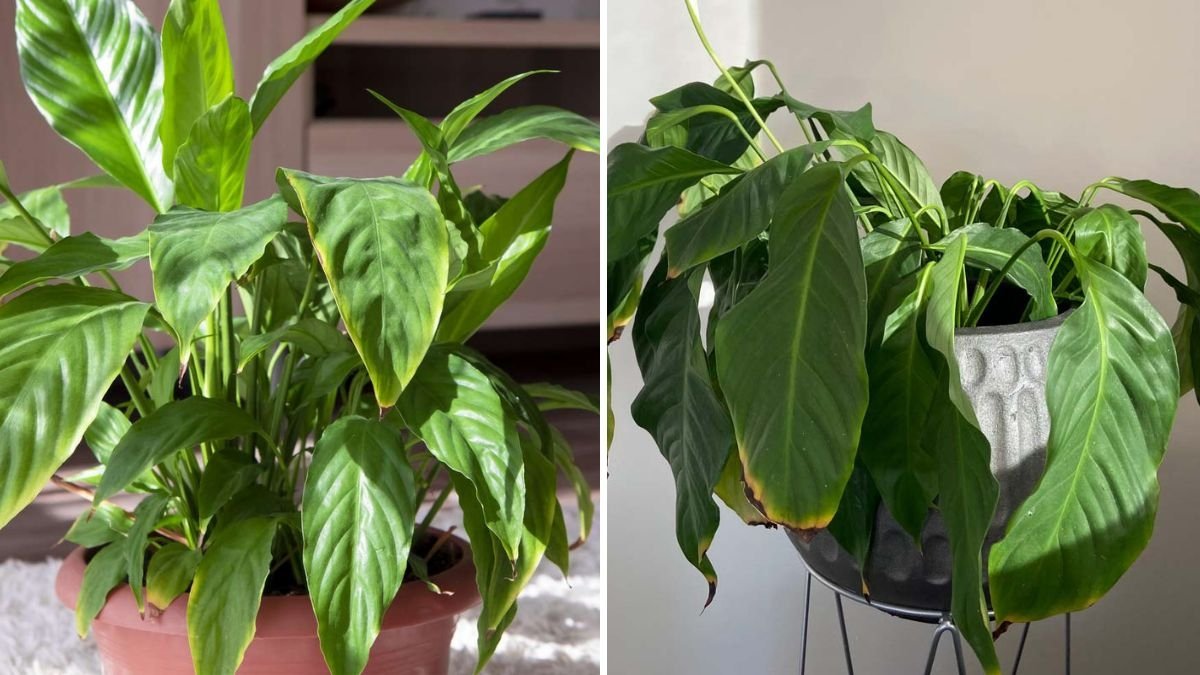




Leave A Comment